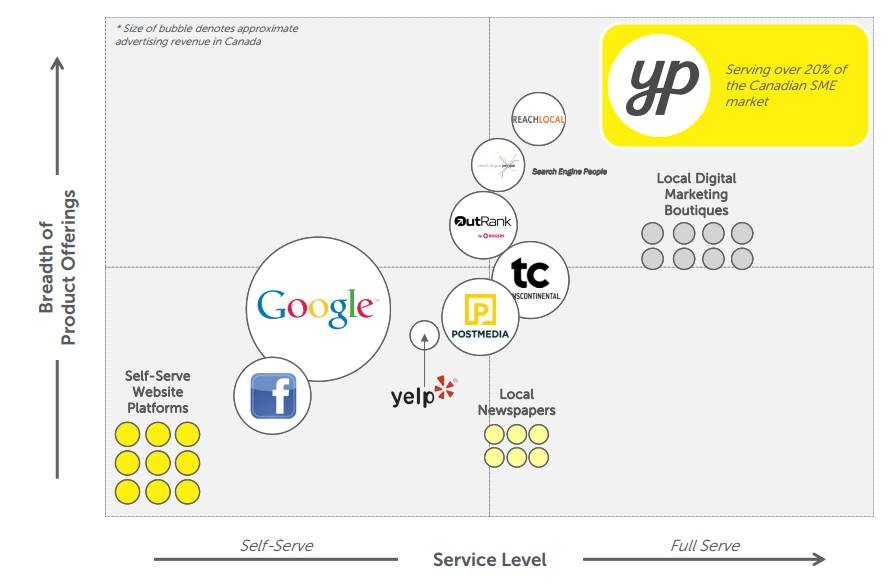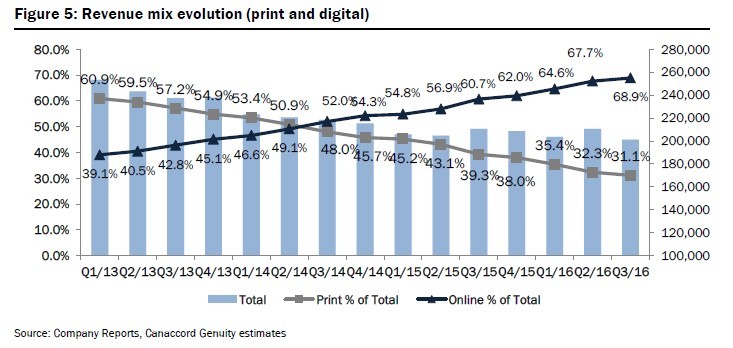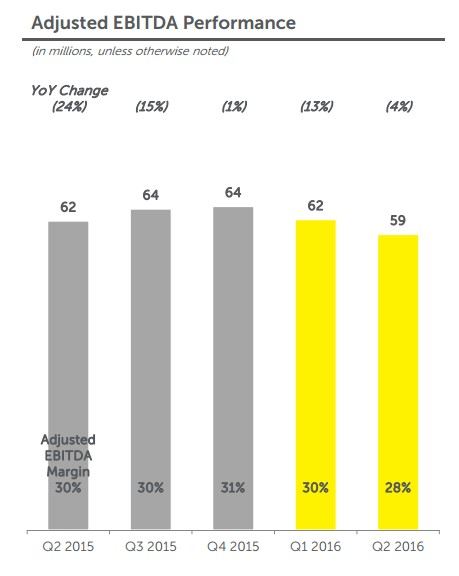Yellow Pages: Evolving to Survive Mass Extinction

The internet and search engines have made printed business and personal directories obsolete. How can Yellow Pages evolve to continue to create value for agents in its value chain?
In the 90s, nearly every home in North America had a thick book printed on yellow pages that listed the telephone numbers of all the businesses in the local area. This book, compiled, published, and distributed by Yellow Pages (TSX: Y), served as a two-sided information sharing platform in local markets, amassing a network of local businesses (SMEs) and matching them with a large consumer base who need the products and services provided. For decades, YP defended its network of SMEs and consumer with an aggressive sales force that sold ad space and a robust distribution network to make sure a phone book was delivered to every home.
As the Internet became the most popular information sharing platform, YP’s printed directories are more likely to be found in recycling bins than next to telephones. In 2016, 40% of Americans use a directory at least once a month compared to in the 1980s, when 50% of Americans used a directory every day.[i] Businesses quickly flocked to the cheaper, more effective advertisement online. The print directories platform was trending toward a death spiral as its networks shrank below critical mass on both sides. By 2009, three major directory businesses had filed for bankruptcy.[ii]
Source: http://businessmodelinstitute.com/final-nail-in-coffin-of-yellow-pages-business-model/
Evolution from Print to Online
Unlike its competitors, YP was quick to react to the changing landscape. It began to acquire online directory companies in 2007 and had made 11 acquisitions by 2010.[iii] Realizing that companies like Google are providing directory services for free, YP shifted its business model from directories to a full service, multi-channel marketing solutions company.
Yellow Pages’ Transformed Market Positioning[iv]
To create more value for SMEs, YP bundled print and online directory services with marketing consultancy services such as multi-channel marketing plans, search engine optimization, social media placement strategies, and consumer data analytics.[v] To create more value for consumers, YP made its directory easier to use across multiple platforms and industries. The YP platforms are available across industries, including business & people search, real estate, retail, and dining.[vi]
To support these initiatives, YP has restructured the organization by creating over 400 positions in digital marketing, media, and IT and shedding 300 positions that are not aligned with digital operations.[vii] Despite the changes, YP has maintained its sales and customer account services functions to continue its focus on providing top service to both business and consumers.
Additionally, YP is pursuing a “Return to Growth Plan” focused on four operational levers to improve growth and profitability and it transitions its business model:[viii]
- Extend brand promise: launch advertising campaigns across media channels to highlight improved content and search functionalities available on the mobile app and online platforms
- Strengthen media assets: Improve user experience for consumers
- Enhance go-to-market strategy: Increased customer (SME) acquisition and retention by investing in sales force, providing data analytics, and improving customer service through a B2B solutions website
- Improve business efficiency: rationalize the shrinking print segment of the business
Yellow Pages Today
Despite growth of the digital business as a % of the total revenue, YP’s top line has consistently shrank since 2013. After a disappointing earnings release earlier in November 2016, share price dropped 13.6% from C$22.00 to C$19.00. Worried by a declining customer count, many research analysts have expressed concerns about YP’ growth in the digital segment and downgraded its rating. [ix]
Next Steps
YP has found a way to survive, but it is by no means thriving. Profitability has been declining as the digital segment is replacing the more profitable segment.[x]
In order for the company to still exist in the next 5 years, YP needs to:
- Differentiate from competitors by focusing on smaller and local businesses. YP needs to leverage its well established brand and network in local geographies to compete with newer, more tech-savvy companies like HubSpot. YP can use its local expertise to develop bespoke marketing strategies for local SMEs to create this differentiation.
- Keep print segment to generate cash. Although the industry is shrinking, print directories is still a $3 billion industry.[xi] It provides stable cash flows, and its target customers (people over the age of 60) have high disposable income, may not be comfortable with using the internet, and have expensive service needs like home repair and healthcare.[xii] YP should try to keep this segment alive and profitable for as long as possible.
Although YP survived the mass extinction of print directories, does its current business and operating model have enough flexibility to allow it to thrive in this new environment?
(788 words)
Cited Sources
[i] “How Do the Yellow Pages Still Make Money.” https://www.thumbtack.com/blog/how-do-the-yellow-pages-still-make-money/. Pub Date: Oct 2015, Access Date: Nov 2016.
[ii] Palank, Jacqueline. Dex Media Files for Chapter 11 Bankruptcy Protection. http://www.wsj.com/articles/dex-media-files-for-chapter-11-bankruptcy-protection-1463453027. Pub Date: May 2016; Access Date: Nov 2016
[iii] Company Filings, Capital IQ
[iv] Company Presentation, https://corporate.yp.ca/media/filer_public/9f/85/9f8513d5-677a-4b85-9c16-782e93b2f6d4/q2_2016_investor_presentation_english_only.pdf. Access Date: Nov 2016.
[v] Woodie, Alex. “How Big Data Keeps Yellow Pages Group in the Black.” https://www.datanami.com/2013/12/02/how_big_data_keeps_yellow_pages_group_in_the_black/. Pub Date: Dec 2013, Access Date: Nov 2016.
[vi] Company Presentation, https://corporate.yp.ca/media/filer_public/9f/85/9f8513d5-677a-4b85-9c16-782e93b2f6d4/q2_2016_investor_presentation_english_only.pdf. Access Date: Nov 2016.
[vii] “Yellow Pages Announces Corporate Realignment Following Sustained Progress in Digital Transformation. https://corporate.yp.ca/en/yellow-pages-news/press-releases/yellow-pages-announces-corporate-realignment-following-sustained-progress-digital-transformation/. Pub Date: Oct 2015, Access Date: Nov 2016.
[viii] Press Release, https://corporate.yp.ca/media/filer_public/5a/7b/5a7baeaa-e556-4154-afb5-acb8ff69eaeb/2014q2_press_release_and_financial_highlights.pdf, Access Date: Nov 2016
[ix] McReynolds, Drew. “Less Confident on Near-term Re-Rating Potential; Downgrading to Sector Perform.” RBC Capital Markets. Pub Date: Nov 2016, Access Date: Nov 2016.
[x] Company Presentation, https://corporate.yp.ca/media/filer_public/9f/85/9f8513d5-677a-4b85-9c16-782e93b2f6d4/q2_2016_investor_presentation_english_only.pdf. Access Date: Nov 2016.
[xi] Kadet, Anne. “Yellow Pages Hang On in Digital Age.” http://www.wsj.com/articles/yellow-pages-hang-on-in-digital-age-1466157601. Pub Date: June 2016, Access Date: Nov 2016
[xii] “How Do the Yellow Pages Still Make Money.” https://www.thumbtack.com/blog/how-do-the-yellow-pages-still-make-money/. Pub Date: Oct 2015, Access Date: Nov 2016.







Thanks for this post, Nancy. I honestly thought that YP no longer existed. It’s interesting to see in this case, an example of the company whose existence was threatened by digital innovation and how it uses digital technology to survive. I also see this example as an intersection of several concepts we’ve learned, such as in MKT, TOM and LEAD.
I am not very optimistic about YP’s future. While it has found a new lease of life, I wonder if it is doing enough to stay relevant. While you are right that they can still make money from print, we will continue to see a larger drop in print sales in the near future. In terms of its digital segment, there will be increasing competition and it doesn’t seem that YP has strong enough analytics to compete or thrive in this environment. Additionally, looking at the graph you showed, total revenue is on a decreasing trend and unfortunately, I see that trend continuing in the future. Therefore, they may need to acquire companies to get the expertise that they require in the shortest time possible, rather than try to grow organically.
Interesting post, Nancy! I agree with “Milkman”, I didn’t know that the Yellow Pages were still around. I actually find it shocking that 40% of people still use it once a month, I thought that number would have been less than 10%. I will say, I am impressed with their will to survive despite being irrelevant in the digital age. Looking at the numbers, it definitely looks like they need to continue selling the hard copies of the yellow pages to actually grow, but I don’t think counting on the 60+ year olds is the way to go. That generation is becoming more tech-savy and the ones who aren’t will probably not be around for long, unfortunately. Instead, I think YP needs to focus on growing their digital section and increasing the money they make off it. One idea is to completely re-brand and just focus on being a marketing/advertising consulting company. I think they could still print the hard copies (as long as it’s profitable) but that is where their focus should be.
Nancy, this was a very interesting post! I agree with Milkman and HBS2018 that Yellow Pages needs to find other ways to remain relevant if the Company is going to survive long-term. I actually wonder why Yellow Pages decided to transition from directories to a becoming a multi-channel marketing solutions company, which seems to be a far cry from their core competency. I actually think a key growth area in the industry right now is developing platforms to help businesses with multiple locations manage all their content accurately across various data sources (i.e. company’s websites, Google, Facebook, Yelp, Foursquare, etc.). For instance, Yext is a startup in New York that does exactly this, and has generated $88.8 million in revenue as of January 2016, a 48% growth compared to the prior year [1]. For a company like the Yellow Pages which built its business on providing directories to a large consumer base, this seems like a more logical next step compared to marketing solutions.
[1] Katie Roof, “Yext sees $88.8 million revenue, 48% growth for location data,” TechCrunch, March 10, 2016, https://techcrunch.com/2016/03/10/yext-sees-88-8-million-revenue-48-growth-for-location-data/?utm_source=twitterfeed&utm_medium=twitter, accessed November 2016.
Nancy, thanks for this interesting post on the Yellow Pages. The print industry has taken a significant hit in the digital age and many companies are struggling to adapt their business models to today’s information age. This downward trend in sales and circulation can be seen in books, magazines, and newspapers. I admire YP’s proactive response to the changing industry landscape, especially their focus on acquisitions to fund their growth which I believe may be the reason they are still around today. However, they still need to focus on organic growth internally. My only concern with your suggestion about keeping the print business, is the risk that YP’s print books will be profitable enough not just to keep the company afloat but to also fund growth in their digital and advertising segments. In order to stay relevant, YP will need to invest significant time and capital into expanding their digital platform which I’m not sure the print business will be able to support completely. I will be very interested to see if YP is still around in five years and in particular, if they still are printing their age-old directories!
Thanks for the great post, Nancy. I think YP would be wise to take advantage of their historical role in connecting small businesses with consumers, translated to a digital platform. It seems like there is still a lot of white space in helping these SMEs create and maintain an online presence that allows them to easily connect with their patrons. While this space is highly fragmented, a player like YP could be the one that consolidates the market and creates a differentiated offering for SMEs that an enterprise like Google may not want to touch, simply because of the high touch needed to create a foothold in the SME market. I think this could be especially valuable if YP can position itself as the OpenTable for small business and allow service booking in a concentrated place, perhaps by partnering with existing booking software companies that may not have the cache or consumer web presence of YP.
Thanks for the post Nancy. Like everyone else, your post caught my eye because I didn’t think anybody was still using the yellow pages in 2016. In thinking about how YP can effectively play a role in marketing small businesses to consumers, I am reminded of our FRC case on Alibaba. A key lesson that stood out for me from Alibaba was how responsive they were to their SME-customers’ feedback and how that in turn, fuelled their growth. With a declining customer count threatening the viability of this business, I think they may need to take a step back to reassess what is really important to their consumers so that they can develop a compelling service that truly meets their needs. It appears that there is a misalignment between what YP thinks customers need and what they are truly after so doing more of the same is unlikely to yield the desired change. While I agree that they should milk print for as long as possible, this should not detract from efforts to keep the business relevant in such a rapidly changing environment.